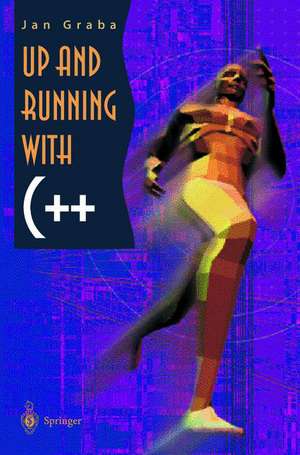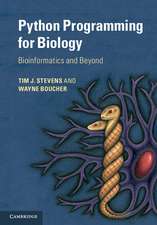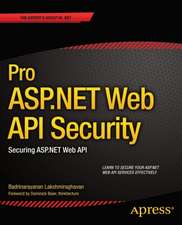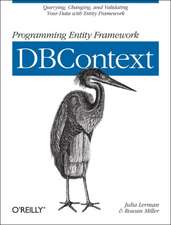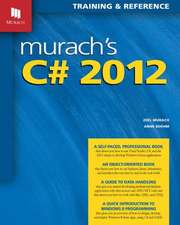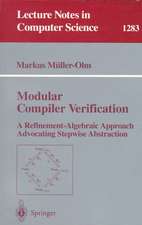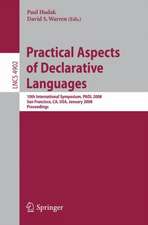Up and Running with C++
Autor Jan Grabaen Limba Engleză Paperback – 17 mar 1998
Preț: 647.79 lei
Preț vechi: 809.73 lei
-20% Nou
Puncte Express: 972
Preț estimativ în valută:
123.97€ • 134.61$ • 104.13£
123.97€ • 134.61$ • 104.13£
Carte tipărită la comandă
Livrare economică 22 aprilie-06 mai
Preluare comenzi: 021 569.72.76
Specificații
ISBN-13: 9783540762348
ISBN-10: 3540762345
Pagini: 316
Ilustrații: IX, 304 p.
Dimensiuni: 155 x 235 x 17 mm
Greutate: 0.48 kg
Ediția:Softcover reprint of the original 1st ed. 1998
Editura: SPRINGER LONDON
Colecția Springer
Locul publicării:London, United Kingdom
ISBN-10: 3540762345
Pagini: 316
Ilustrații: IX, 304 p.
Dimensiuni: 155 x 235 x 17 mm
Greutate: 0.48 kg
Ediția:Softcover reprint of the original 1st ed. 1998
Editura: SPRINGER LONDON
Colecția Springer
Locul publicării:London, United Kingdom
Public țintă
ResearchCuprins
1 The Fundamentals of Object Orientation.- 1.1 Brief Background.- 1.2 Basic Concepts and Terminology.- 1.2.1 Objects.- 1.2.2 Object-Orientated Programming (OOP).- 1.2.3 Inheritance.- 1.2.4 Message-Passing.- 1.2.5 Polymorphism.- 1.3 The Motivation for a New Approach.- 1.4 Why OOP?.- 1.5 The Next Few Chapters.- 2 First Steps in C++ Programming.- 2.1 The Basic Structure of a C++ Program.- 2.2 Basic Data Types and Variable Declarations.- 2.3 Type Conversions.- 2.4 Constants.- 2.5 Standard Input and Formatted Output.- 2.6 Enumerated Types.- 2.7 The Scope of a Variable.- 2.8 The Lifetime of a Variable.- 2.9 Common Operators.- 2.9.1 The Assignment Operator.- 2.9.2 Arithmetic Operators.- 2.9.3 The Bitwise Operators.- 2.9.4 Conditional Operator.- 2.9.5 Compound Operators.- 2.9.6 Comma Operator.- Exercises.- 3 Selections and Iterations.- 3.1 The Relational Operators.- 3.2 Selection Statements.- 3.2.1 The if Statement.- 3.2.2 The switch Statement.- 3.3 Iterations.- 3.3.1 The while Statement.- 3.3.2 The do Statement.- 3.3.3 The for Statement.- 3.4 The Use of break and continue.- 3.5 The Logical Operators.- Exercises.- 4 Functions and Header Files.- 4.1 Functions.- 4.1.1 The C++ Approach and Rationale.- 4.1.2 Function Syntax.- 4.1.3 Inline Functions.- 4.2 Linkage 34.- 4.3 Non-System Header Files.- 4.4 The Multiple Inclusion Problem.- 4.5 Function Overloading.- 4.6 Default Arguments.- Exercises.- 5 Arrays, Pointers and References.- 5.1 Structured Types.- 5.2 Array Declaration and Usage.- 5.3 Array Initialisation.- 5.4 Array Processing.- 5.5 Strings.- 5.6 Pointers.- 5.7 Pointers and Arguments.- 5.8 Arrays and Pointers.- 5.9 The NULL Pointer.- 5.10 Strings Revisited.- 5.11 Functions for String Processing.- 5.12 Memory Allocation for Strings.- 5.13 Reference Types.- 5.14 References as Arguments.- Exercises.- 6 Adding Sophistication to Basic I/O.- 6.1 Handling ‘Whitespace’ in Text Input.- 6.2 The Formatting of Output Via Manipulators.- 6.2.1 Common Manipulators.- 6.2.2 Common Formatting Flags.- Exercises.- 7 Classes in C++.- 7.1 Structures.- 7.2 Explicit Class Declarations.- 7.3 Access Control.- 7.3.1 Private Access.- 7.3.2 Public Access.- 7.3.3 Default Access Levels.- 7.4 Member Function Definitions.- 7.5 Using a Class.- 7.6 Inline Member Functions.- 7.7 Constructors.- 7.7.1 General Purpose, Syntax and Rationale.- 7.7.2 Constructor Overloading.- 7.7.3 Default Constructors.- 7.7.4 Copy Constructors.- 7.8 Destructors.- 7.9 Arrays of Objects.- 7.10 Objects Within Objects.- 7.11 The this Pointer.- 7.12 Static Class Members.- Exercises.- 8 Dynamic Memory Management.- 8.1 Introduction.- 8.2 new and delete.- 8.3 Dynamic Memory Usage with Classes.- 8.4 Dynamic Data Structures.- 8.5 Dynamic Arrays of Objects.- 8.6 Dynamic Instance Variables.- Exercises.- 9 Inheritance.- 9.1 Inheritance in the Context of Object Orientation.- 9.2 Inheritance in C++.- 9.2.1 Syntax.- 9.2.2 Access Rights of Derived Classes.- 9.2.3 Base Class Constructors In Initialisation Lists.- 9.2.4 Bringing it all Together.- 9.2.5 Redefining Inherited Functions.- 9.2.6 The Assignment Compatibility Rule.- 9.3 Designing a Class Hierarchy.- 9.3.1 Existing Methods.- 9.3.2 General Principles.- 9.3.3 Windows Interface Example.- 9.3.4 MLS. Example.- Exercises.- 10 Polymorphism.- 10.1 Polymorphism in the Context of Object Orientation.- 10.2 The Assignment Compatibility Rule Revisited.- 10.3 Function Binding.- 10.4 Virtual Functions.- 10.5 Constructors and Destructors.- 10.6 Pure Virtual Functions and Abstract Base Classes.- 10.7 Heterogeneous Linked Lists.- Exercises.- 11 Friend Functions and Operator Functions.- 11.1 Access Problems.- 11.2 Friend Functions.- 11.2.1 Individual Friend Functions.- 11.2.2 Friend Classes.- 11.3 Operator Functions and Operator Overloading.- 11.3.1 General Use of Operator Functions.- 11.3.2 Operator Functions Within Classes.- 11.3.3 The Input and Output Operators.- 11.3.4 Multiple Overloading of Operator Functions.- 11.3.5 The Assignment Operator.- 11.3.6 Assignment v Initialisation.- Exercises.- 12 File Handling.- 12.1 File Streams.- 12.2 Opening and Closing Files.- 12.2.1 Creating an Unattached Stream.- 12.2.2 Creating an Attached Stream.- 12.3 Writing and Reading Lines To/From a Text File.- 12.4 Character-Level I/O.- 12.5 cin and cout as Files.- 12.6 Using Command Line Parameters.- 12.7 Random Access.- 12.7.1 The File Pointer.- 12.7.2 Reading and Writing.- 12.7.3 Testing for End of File.- Exercises.- 13 Templates.- 13.1 Introduction.- 13.2 Template Functions (‘Generic Functions’).- 13.3 Parameterised Types (‘Generic Types’).- Exercises.- Appendix A Exception Handling.- Appendix B Platform Variations.- B.1 Borland C++.- B. 1.1 Creating and Running a Program.- B.1.2 Single-key Input.- B.1.3 Screen-Handling.- B.2 Unix Implementations.- B.2.1 Compiling and Running a Program.- B.2.2 Unix Screen-Handling.- Appendix C Stream Formatting.- Model Solutions to Programming Exercises.
Caracteristici
Teaches the fundamental concepts of object orientation and the implementation of those concepts in C++ * Uses examples throughout, to illustrate the material and each chapter contains a series of programming exercises, making it very reader-friendly * Aimed at people with knowledge of another high level programming language, and does not assume any knowledge of C++
